Metallic elements make up approximately 25% of the Earth’s crust by mass, and they are essential to nearly every modern technology, from jet engines and medical lasers to smartphones and solar cells.
While common metals like Aluminium (about 8.2% of crust) and Iron (5.6%) dominate the geological landscape, some metals are so scarce that their concentrations are measured in parts per million (ppm) or parts per billion (ppb).
For example, Rhodium exists at crustal abundances below 0.0002 ppm. That means that for every 5 billion atoms of crustal material, only about one atom is rhodium. [1]
What makes these metals truly fascinating is not merely their scarcity, but the combination of geological rarity, low annual production, and high industrial importance.
In this article, I explore some of the rarest metals on Earth, ranking them using a combination of crustal abundance (ppm), annual production volume, and real-world extractability. The list includes both well-known precious metals and obscure but technologically critical elements.
Note: I haven’t included radioactive metals that have very short half-lives and are only made in laboratories (in nanograms) for research.
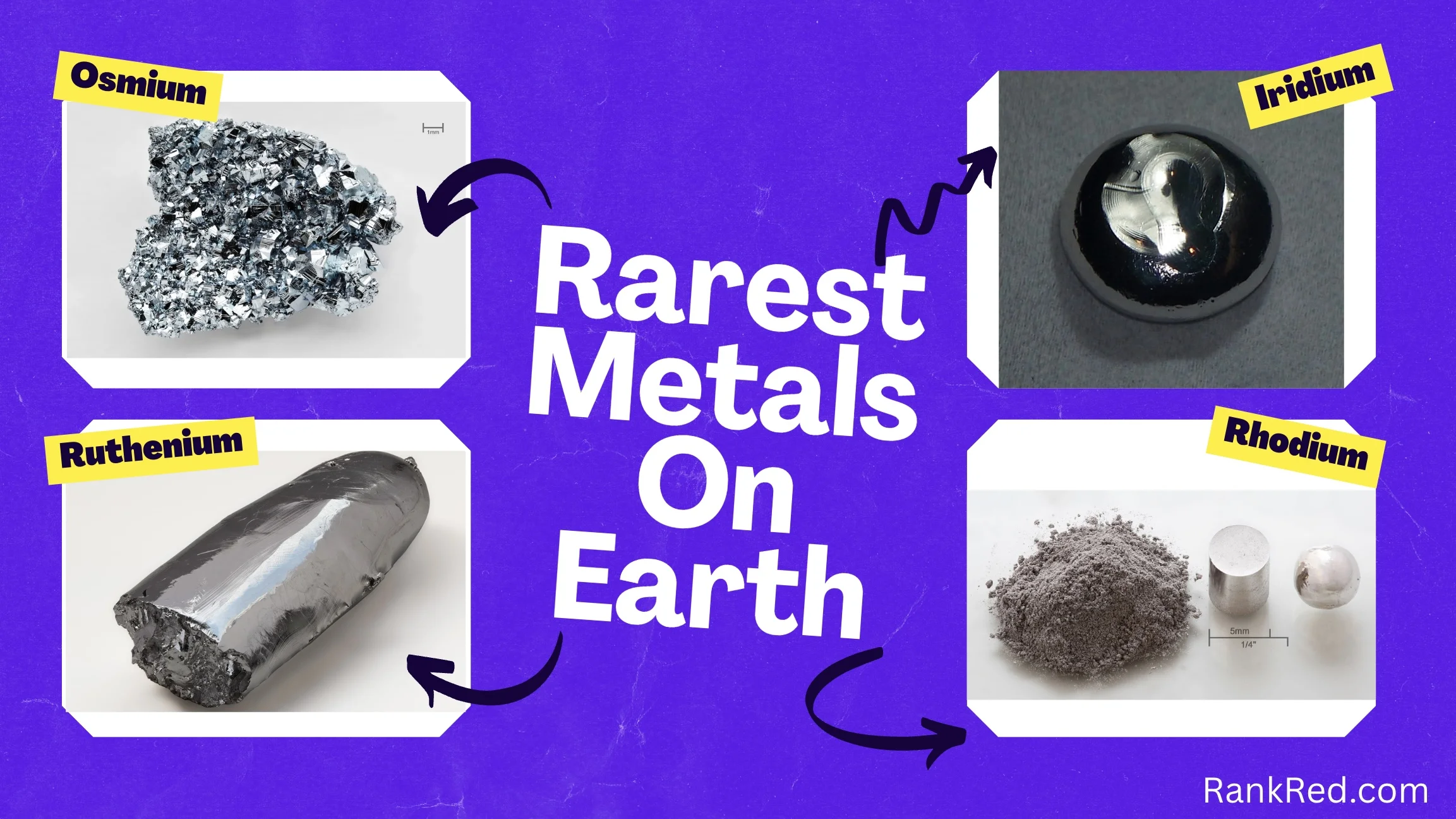
The rarest metal on Earth is actually Francium (Fr), but because this unstable element has a half-life of only 22 minutes, it has no practical use. It is also the second-rarest naturally occurring element after Astatine (At). [2]
Table of Contents
13. Bismuth
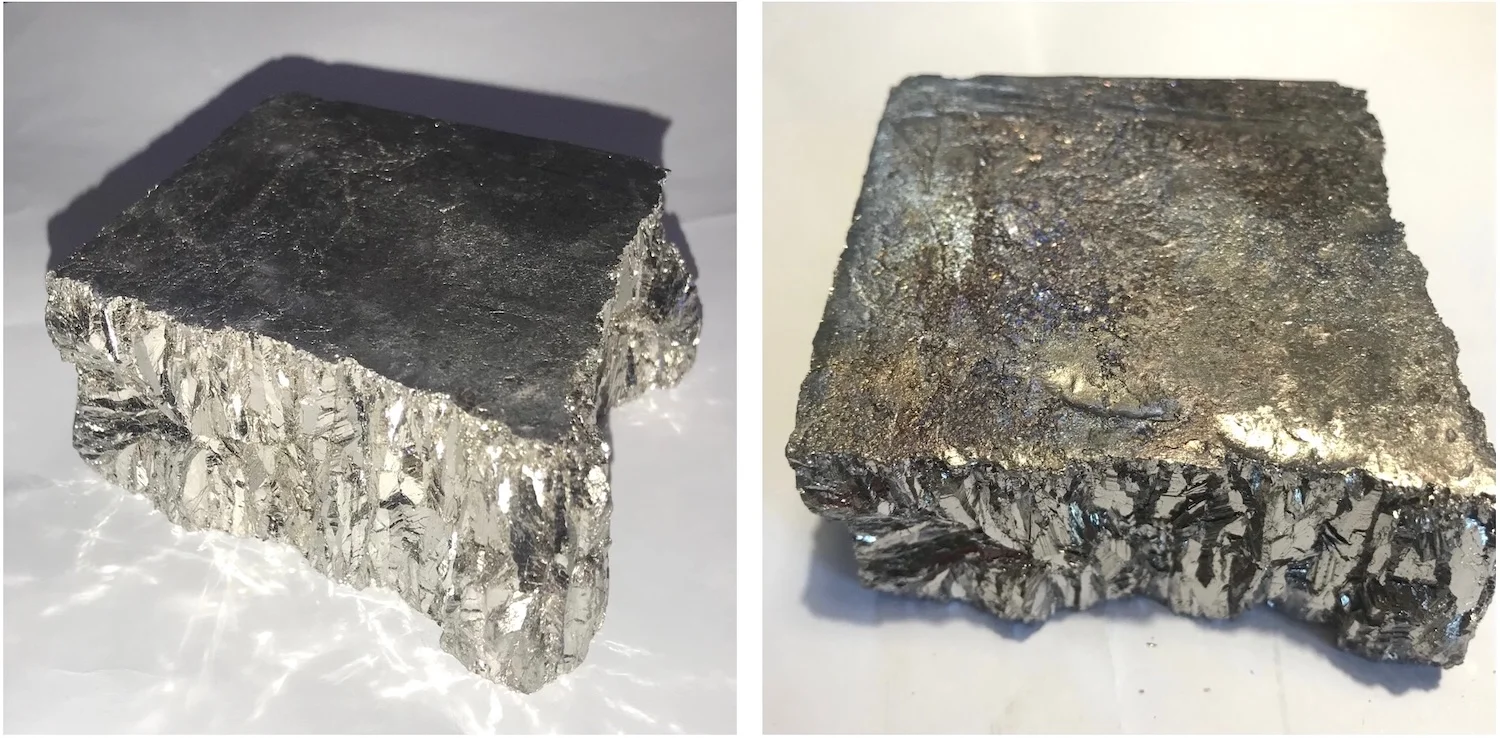 Chunk of a broken bismuth ingot
Chunk of a broken bismuth ingot
Crustal abundance: 0.18 ppm
Production: 16,000 metric tons annually
Price: ~$15 per pound
Bismuth is a heavy, brittle, silver-pink element with a rare combination of physical, chemical, and biological properties. It hardly occurs in native form; it is found mostly in small quantities within lead, copper, tin, and tungsten ores.
It has extremely low toxicity, especially when compared to other heavy metals. Unlike lead, cadmium, or mercury (metals with similar atomic characteristics), bismuth is biologically safe enough to be consumed in pharmaceuticals. [3]
It is less soluble in bodily fluids and has a tendency to form harmless, easily excreted compounds. This unique property makes bismuth a key ingredient in medicines such as antacids, anti-diarrheal tablets, and treatments for Helicobacter pylori infections.
Bismuth also exhibits remarkable physical behavior. It expands upon freezing (one of the only metals besides water to do so), which gives it exceptional casting accuracy and makes it useful in low-melting alloys for safety devices and fire sprinkler systems.
Plus, its low melting point of 271.4°C allows bismuth to form fusible alloys that liquefy at temperatures below 100°C, making it valuable for electrical fuses, molds, metallurgical solders, and proximity sensors.
12. Mercury

Crustal abundance: 0.085 ppm
Production: ~1,200 metric tons annually
Price: ~$200 per kilogram (pure form)
Mercury is one of the most unique elements in the periodic table — a silvery, fluid metal that remains liquid at room temperature. Its rarity, unusual physics, and powerful chemical behavior have made it both an essential industrial material and one of the most tightly regulated substances on Earth.
It occurs primarily in the mineral cinnabar (HgS). But since cinnabar deposits are usually small and geographically limited, global mercury production has always been relatively modest.
Mercury has an extremely high density (13.53 g/cm³) and can expand and contract uniformly with temperature. These properties make mercury essential for precision scientific instruments such as thermometers, barometers, and manometers.
It conducts electricity well and forms amalgams with many metals, which is why it is widely used in electrical switches, dental fillings, and gold extraction. Plus, mercury’s role in gold mining, where it binds with gold particles to form an amalgam, has made it a crucial metal in extraction methods for centuries.
However, mercury’s chemical behavior has a darker side. While metallic mercury is relatively inert, its organic compounds (particularly methylmercury) are extremely toxic. This led to strict global regulations and the gradual phasing out of mercury in many consumer and industrial applications. [4]
11. Silver
Discovery: 3000 BCCrustal abundance: 0.075 ppm
Production: 25,000 metric tons annually
Price: ~$53 per troy ounce
For thousands of years, silver has been used to mint coins, create jewelry, and craft ceremonial objects. Yet behind its historical prestige lies its true scientific identity: silver has the highest electrical and thermal conductivity of all metals.
This makes it indispensable in electronics, solar panels, high-performance switches, printed circuit boards, and advanced battery systems. In fact, nearly every electronic device contains a small amount of silver.
Silver has extremely high reflectivity across the visible spectrum, which makes it ideal for mirrors, optical coatings, and advanced photovoltaic technologies. It also has strong antimicrobial properties, which is why silver ions are widely used in medical dressings, water purification systems, and antibacterial coatings.
The demand for silver in newer technologies continues to rise: for example, silver nanoparticles are used in conductive inks, printed electronics, antimicrobial coatings, and so on.
In 2024, Mexico produced 6,300 metric tons of silver, making it the world’s top silver producer. China followed with 3,300 metric tons, and Peru came next with 3,100 metric tons. The global silver market is projected to grow steadily, reaching $30 billion by 2035 at an annual growth rate of 3.25%. [5][6]
10. Indium
Discovery 1863Crustal abundance: 0.05 ppm
Production: 1,080 metric tons annually
Price: ~$380 per kilogram
Indium is one of the world’s most essential high-tech metals — a soft, silvery-white element that quietly powers modern display technology, touchscreens, semiconductors, and advanced electronics.
With a crustal abundance of approximately 0.05 ppm (50 parts per billion), indium is rarer than silver, cadmium, and even many precious metals. It is found only in trace quantities within zinc and lead sulfide ores, particularly sphalerite (ZnS).
Indium has unique physical and electronic behavior. It can be pressed with a fingernail, bent easily, and cut without producing sparks.
However, when alloyed or oxidized, indium forms compounds with extraordinary electronic properties. The most important of these is indium tin oxide, a transparent, electrically conductive material used in virtually every touchscreen device and LED.
Compounds like indium phosphide (InP) and indium gallium arsenide (InGaAs) are used in high-speed electronics, laser diodes, fiber-optic communication systems, and advanced photovoltaic cells.
It is interesting to note that China accounts for approximately 70% of the world’s refined indium production. The other major producers are South Korea (around 15%), Japan (about 7%), and Canada (roughly 6%). [7]
9. Tellurium
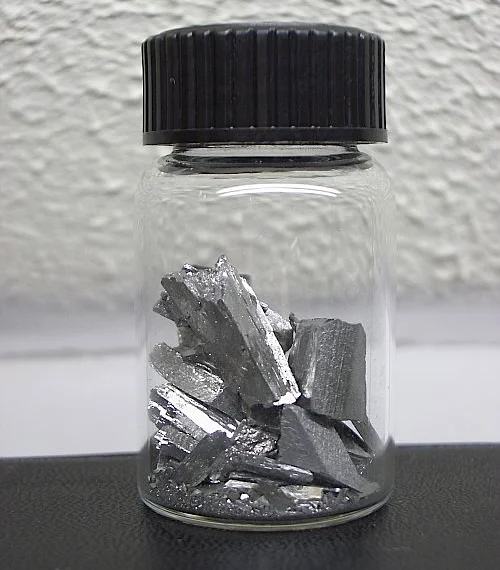 Pieces of tellurium in a vial
Pieces of tellurium in a vial
Crustal abundance: 0.001 ppm
Production: 650 tons annually
Price: ~$110 per kilogram
Tellurium is one of the rarest and most strategically important semi-metals on Earth, belonging to the chalcogen family alongside selenium and sulfur.
Unlike common industrial metals, tellurium occurs almost exclusively as a byproduct of copper refining (not as a primary ore). This unique geological and industrial bottleneck makes tellurium’s supply fundamentally constrained.
It has an unusual combination of metallic and non-metallic properties. Pure tellurium is a brittle, silver-white element with a metallic luster, yet its electrical conductivity increases as temperature rises — a characteristic typical of semiconductors rather than metals.
This hybrid nature allows tellurium to form compounds with exceptional electronic and thermal properties. For example, cadmium telluride (CdTe) has become one of the most successful photovoltaic materials for thin-film solar panels, offering lower production costs and stable performance under real-world conditions.
Tellurium is also used for creating thermoelectric devices that convert heat directly into electricity, offering high efficiency in waste-heat recovery systems.
In market terms, the global tellurium market is expected to reach about 851 tons by 2030, growing at a CAGR of ~5.12%. [8]
8. Palladium
 Platinum-palladium ore from a mine in Montana, US
Platinum-palladium ore from a mine in Montana, US
Crustal abundance: 0.015 ppm
Production: 190 metric tons annually
Price: ~$1,400 per ounce
Palladium is relatively rare in nature. It typically occurs as an associated metal in nickel-copper sulphide ores or in platinum-group metal deposits, rather than in large dedicated ore bodies of its own.
Although palladium resembles platinum chemically, it offers several unique advantages that make it the dominant metal in automotive catalytic converters for gasoline engines. It can absorb hydrogen at extraordinarily high ratios, form strong catalytic bonds, and withstand repeated heating cycles.
These properties make it ideal for converting harmful emissions such as carbon monoxide and hydrocarbons into less harmful compounds.
More specifically, it can absorb up to 900 times its own volume in hydrogen gas at room temperature, a property that has led to its use in hydrogen sensors, storage, and chemical processes. [9]
In 2024, global palladium production was around 190 metric tons, slightly lower than in recent years. Russia was the top producer, followed by South Africa, and together, these two countries supplied more than 75% of the world’s palladium.
The palladium market is expected to keep expanding, reaching over $16 billion by 2030 with an annual growth rate of 8.2%.
7. Gold
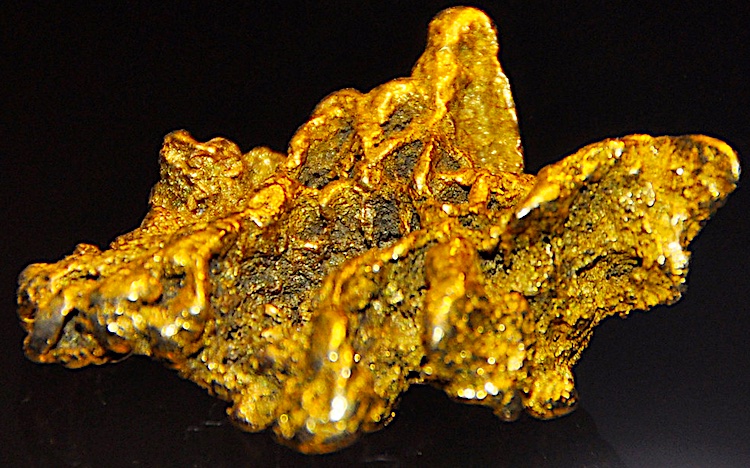
Crustal abundance: 0.004 ppm
Production: 3,300 metric tons annually
Price: ~$4,170 per ounce
Gold is the most iconic metal in human history. It has shaped civilizations, driven exploration, fueled wealth systems, and symbolized beauty and prestige for thousands of years.
In its pure form, gold is soft (thus often alloyed for jewellery or coins) and exceptionally stable. It doesn’t corrode or tarnish under ordinary conditions, which contributes to the perception of gold as “eternal.”
Its exceptional electrical conductivity, malleability, and corrosion resistance make it ideal for electronics, aerospace systems, medical devices, and precision engineering. Modern tech, including smartphones, satellites, and advanced semiconductors, depends on gold components for their reliability and long-term stability.
Gold’s biocompatibility also makes it suitable for dental applications, medical implants, and cancer-targeting drug delivery systems. [10]
In a true sense, gold is as much an asset as it is a metal. While most rare metals are valued mainly for their industrial uses, gold also plays a major role in investment, monetary reserves, and long-term wealth storage — giving it a very different market profile.
The global market for gold is extremely deep, liquid, and worldwide. Whether via jewellery demand in India/China, central bank reserve, or investment through ETFs and physical bullion, gold has far broader demand drivers than most other rare metals.
6. Platinum
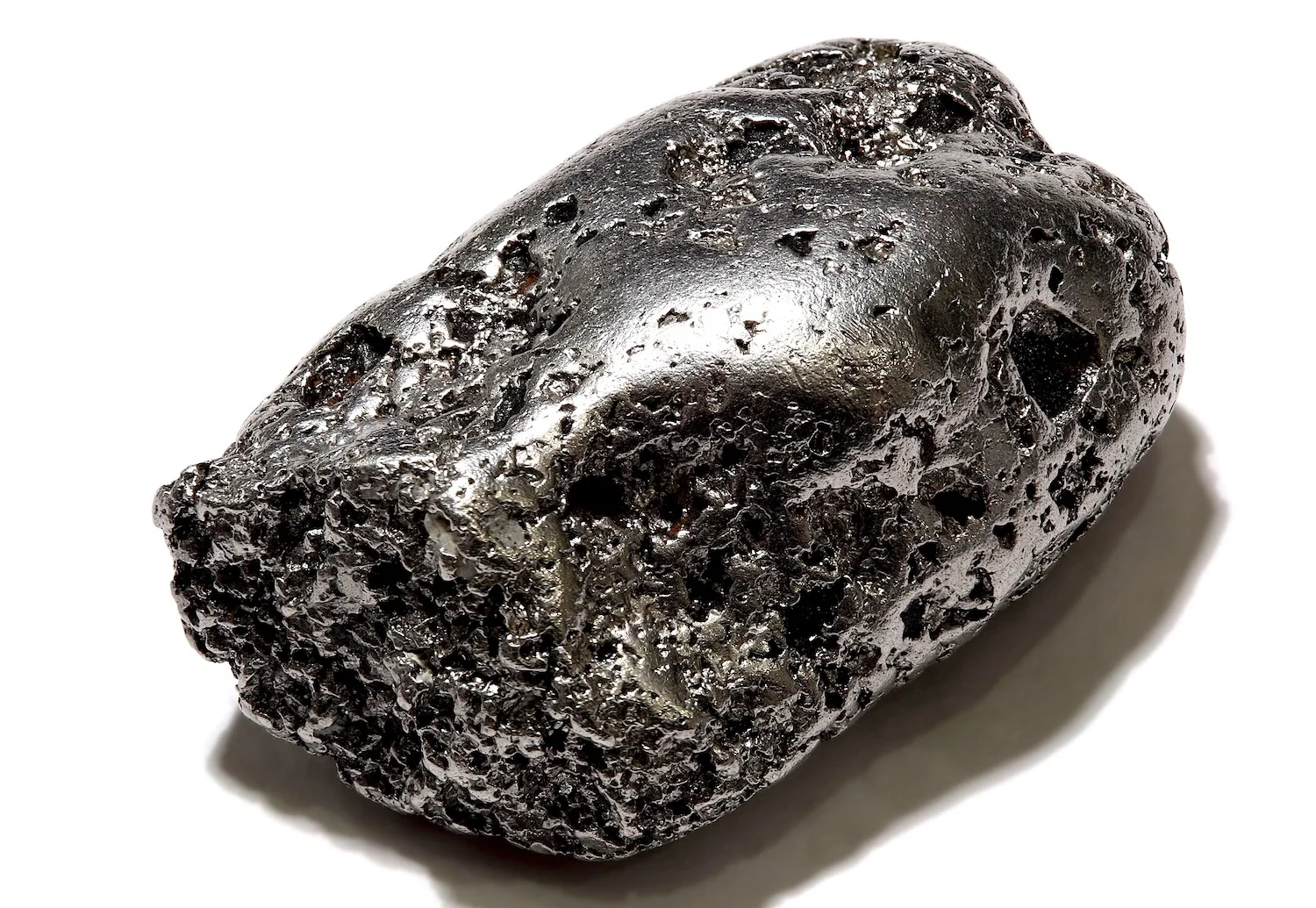 A platinum nugget
A platinum nugget
Crustal abundance: 0.005 ppm
Production: 170 metric tons annually
Price: ~$1,580 per troy ounce
Platinum is a symbol of luxury, durability, and technological prestige. With a crustal abundance of just 0.005 ppm, platinum is far rarer than gold, silver, or most base metals.
Its scarcity is compounded by the fact that platinum rarely forms concentrated ores. Instead, it typically occurs at microscopic levels within complex geological structures, especially layered ultramafic intrusions like South Africa’s Bushveld Complex. This limited distribution makes platinum both a treasure of the Earth and a cornerstone of modern technology.
Since it is extremely resistant to corrosion and does not oxidize in air even at elevated temperatures, platinum finds both industrial and investment uses: in jewellery, in catalytic converters for automobiles, in laboratory and medical equipment, and increasingly in green-energy technologies.
Its density of 21.45 g/cm³ (nearly twice that of silver and almost as dense as iridium) further enhances its mechanical strength and wear resistance. As a result, platinum alloys remain the material of choice for aircraft turbine coatings and high-performance electronics.
Unlike many metals, platinum is non-reactive in biological systems, making it one of the few metals safe for long-term use in pacemakers, implantable electrodes, and medical sensors.
The platinum market is also expected to grow steadily, with a projected 6.3% annual growth rate and a market value of $13.34 billion by 2032. [11]
5. Rhenium
 High-purity rhenium metal
High-purity rhenium metal
Crustal abundance: 0.001 ppm
Production: 50-60 metric tons annually
Price: ~$4,300 per kilogram
Rhenium is not only one of the rarest naturally occurring elements but also one of the highest-melting metals ever discovered.
It has no native ores; instead, it occurs only in trace amounts within molybdenum and copper deposits, typically at 1-2 ppm relative to the host mineral.
Its most important application is in superalloys for jet engines, where rhenium enables turbine blades to operate in environments exceeding 1,900°C. In fact, rhenium-containing superalloys make up more than 80% of the components inside the hottest sections of modern aircraft engines.
Rhenium’s extreme properties come from its atomic structure. It has a melting point of 3,186°C, second only to tungsten (3,422°C) among all metals. Its boiling point exceeds 5,590°C, and its density of 21.02 g/cm³ makes it one of the densest elements known.
These properties give rhenium unmatched resistance to creep, deformation, oxidation, and failure at high temperatures.
Beyond aerospace, rhenium plays a crucial role in petrochemical catalysis. Rhenium-platinum catalysts are essential for high-octane fuel production (reforming naphtha into valuable aromatic hydrocarbons). This application alone consumes nearly 20% of the annual rhenium supply. [12]
4. Ruthenium
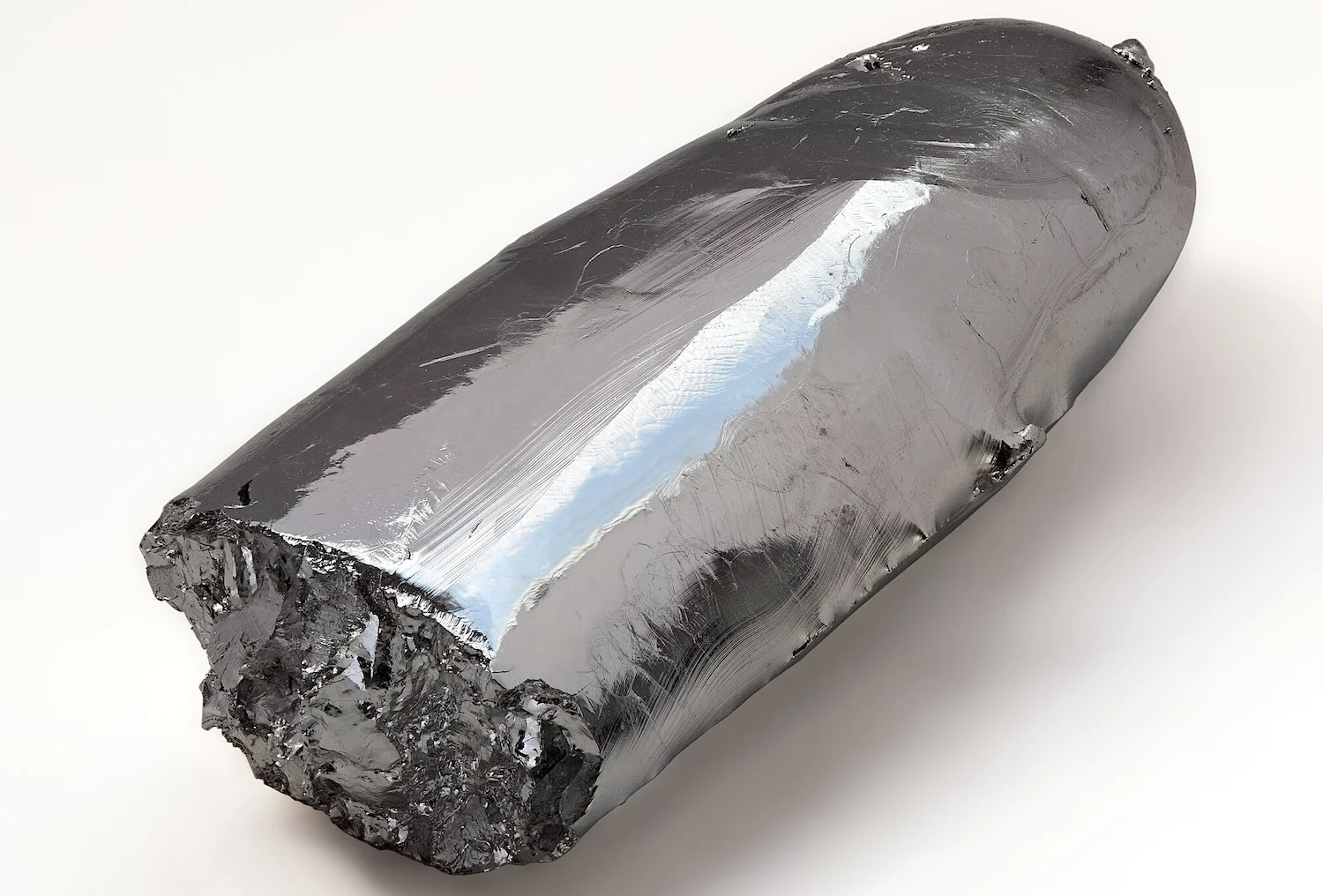 High-purity (99.99%) ruthenium bar
High-purity (99.99%) ruthenium bar
Crustal abundance: 0.000037 ppm
Production: 35 metric tons annually
Price: ~$920 per ounce
Ruthenium is a hard, silvery-white transition metal. It’s extremely rare in the Earth’s crust, with an abundance of only about 0.000037 ppm, roughly 100 parts per trillion.
Because it almost never occurs in pure form, ruthenium is extracted solely as a byproduct of platinum and nickel refining, making its global supply permanently limited and heavily dependent on the mining output of other platinum group metals.
Ruthenium is valuable because of its unique physical and chemical properties. It resists corrosion and stays structurally stable even under high temperatures and harsh chemical conditions. With a melting point of 2,334°C, it is classified as a refractory metal.
These traits, combined with high catalytic activity, make ruthenium indispensable in chemical synthesis, electronics, and advanced materials.
Ruthenium is widely used in the electronics industry. It’s a crucial component in magnetic read-write heads, chip resistors, and hard-disk drive platters due to its ability to maintain magnetic stability at extremely small scales. [13]
It is also used to create thick-film resistors, providing long-term stability, and as a contact material in high-reliability switches and connectors due to its hardness and resistance to wear.
In 2023, the world produced about 35 metric tons of ruthenium, and South Africa alone supplied over 28 tons, accounting for nearly 80% of global output, followed by Russia and North America. By 2033, the ruthenium market is expected to reach $500 million, growing at a 6.17% annual rate.
3. Osmium

General concentration: 0.001 ppm
Production: 100-1000 kilograms annually
Price: ~$2,400 per gram (no standardized market price)
Osmium is intensely hard, remarkably brittle, and geochemically scarce.
However, it is most famous for being the densest naturally occurring element, with a density of 22.59 g/cm³. This extraordinary density gives osmium unique strength, rigidity, and wear resistance, but it also makes the pure metal extremely brittle. [14]
This pure metallic osmium has one more problematic side: when exposed to air, it slowly oxidizes into osmium tetroxide (OsO₄), a volatile, toxic, and highly reactive compound. Although OsO₄ is useful in microscopy, it’s dangerous to handle and needs strict safety controls in industrial environments.
Since osmium never forms concentrated ores, it is encountered only in microscopic amounts within platinum-bearing rocks or nickel-copper sulfide deposits. It is so rare that many mine operators may process hundreds of thousands of tons of ore without ever isolating more than a few grams of osmium.
Only a fraction is processed into crystalline form. In 2023, for instance, only about 3.8 kg was processed into crystalline form, resulting in over 12,000 authenticated items for the luxury and investment market.
From a materials science perspective, there are interesting recent studies: for example, investigations into osmium’s behaviour under extreme pressures have observed electronic topological transitions in osmium crystals, demonstrating how even fundamental physical research is ongoing. [15]
2. Iridium
 1 gram of pure iridium
1 gram of pure iridium
Crustal abundance: 0.001 ppm
Production: 8-9 tonnes annually
Price: ~$165,100 per kilogram
Iridium is among the rarest, densest, and most corrosion-resistant metals ever discovered. Its concentration is estimated at about 0.001 ppm, equivalent to 1 part per billion by mass. This means iridium is even rarer than platinum and gold.
What makes this metal exceptionally fascinating is not just its rarity but also its extreme physical properties. It is the second-densest metal known (after osmium). Its density of 22.56 g/cm³ makes iridium nearly twice as dense as lead.
Iridium’s high melting point of 2,446°C places it among the most refractory metals in existence, capable of withstanding temperatures that destroy almost every other substance.
Plus, Iridium does not oxidize, tarnish, or degrade even when exposed to strong acids, seawater, or extreme temperatures. It remains chemically stable over centuries, which is why it is used in scientific reference standards and long-life components.
For example, the tips of premium spark plugs often contain iridium because it can survive millions of ignition cycles over 100,000 miles of vehicle operation without degradation.
Iridium’s geological distribution is extremely uneven; it is found only in microscopic quantities in ultramafic rocks and within the deepest layers of the Earth’s crust. That’s why it cannot be mined directly. Instead, it is extracted exclusively as a trace byproduct of nickel and platinum refining, which permanently constrains its global supply.
Reports suggest that the iridium market will reach $3.7 billion by 2030, growing at about 5.3% per year. This growth is mainly driven by its use in spark plugs, electronics, and chemical catalysts.
1. Rhodium
 Rhodium foil and wire
Rhodium foil and wire
Crustal abundance: 0.0002 ppm
Production: 34-35 tonnes annually
Price: ~$8,000 per troy ounce
Rhodium’s extreme scarcity, combined with exceptional chemical and physical properties, makes it one of the most valuable commodities in the metal markets.
Rhodium is extremely rare in nature: the Earth’s crust contains only about 0.0002 ppm of it. That means in a million kilograms of crustal rock, you’d find only about 200 milligrams of rhodium. Because it’s so scarce, miners don’t look for rhodium on its own. Instead, it’s usually recovered as a tiny byproduct when refining platinum and nickel ores.
What makes this metal unique is its unmatched catalytic ability. It is the world’s best-known nitric oxide reducer, and no other element matches its efficiency at catalyzing the conversion of harmful exhaust gases into safer compounds.
This single property has made rhodium an indispensable component of automotive catalytic converters, particularly for gasoline engines.
And since it is extraordinarily resistant to corrosion, tarnish, and chemical attack, rhodium is also used to plate optical instruments, electrical contacts, laboratory equipment, and luxury products. A layer of rhodium just 0.1 microns thick can protect jewelry for decades because the metal does not oxidize at room temperature.
When it comes to price, rhodium has shown extreme highs. At its peak, it sold for more than 10 times the price of gold, making it the most expensive metal ever traded. In fact, in March 2021, rhodium was worth over 16 times the price of gold per ounce.
The rhodium market size is projected to exceed 43.5 tons by 2030, growing at a CAGR of 4.7%. This increase is mainly driven by rising vehicle production and stricter emission rules in the US, Europe, China, and India. [16]
Read More
- 23 Rarest And Most Expensive Materials On Earth
- 9 Best Examples of Monopoly In the Real World
- 14 Rarest Cars In The World
- Research Starters Home, Rhodium is classified within the platinum-group metals, EBSCO
- JEE Chemistry, Francium is an extremely rare and highly unstable element, Allen
- Bismuth, A biocentric tour of the periodic table, ScienceDirect
- Projects, Supporting the gradual phasing-out of mercury in the Guianas, FFEM
- Chemicals & Resources, Mine production of silver worldwide, Statista
- Metals & Alloys, Silver market research report, Market Research Future
- Chemicals & Resources, Leading countries based on production of indium, Statista
- Industry Report, Tellurium market size & share analysis, Mordor Intelligence
- Mitva Choudhary, Enhanced hydrogen gas sensing using PdGO thin films, ScienceDirect
- Rua J. Kadhim, Biocompatibility of gold nanoparticles, ScienceDirect
- Industry Report, Platinum market and global forecast, ResearchandMarkets
- Rhenium, World mine production and reserves, US Geological Survey
- University of Minnesota, Ruthenium has unique magnetic properties at room temperature, Sciencedaily
- Bipro Das, 15 most dense materials on Earth by volumetric mass density, RankRed
- Gavin Woolman, Detectability of core level crossing & electronic topological transformations in Osmium, arXiv
- Industry Report, Rhodium market size & share analysis, Mordor Intelligence


